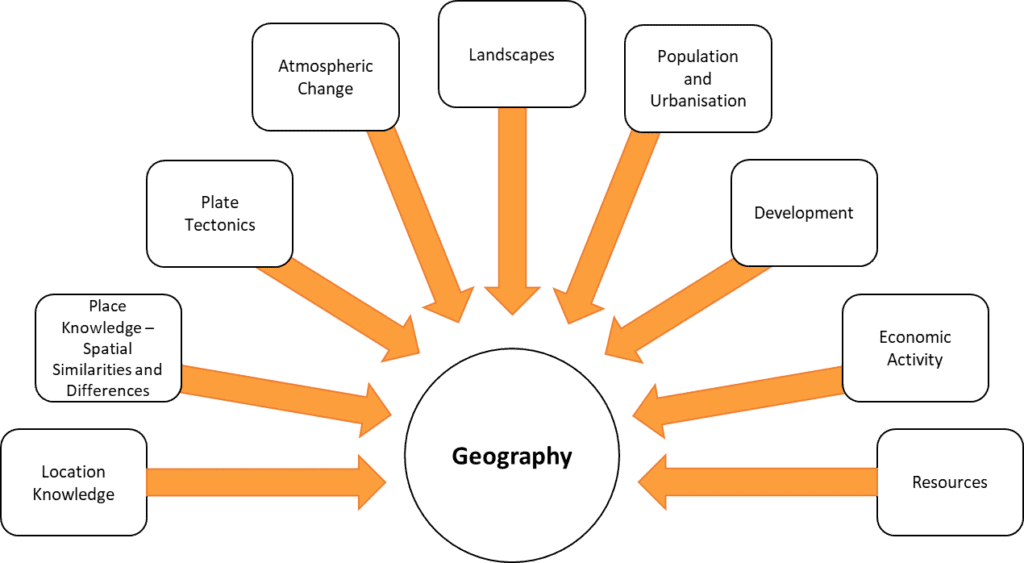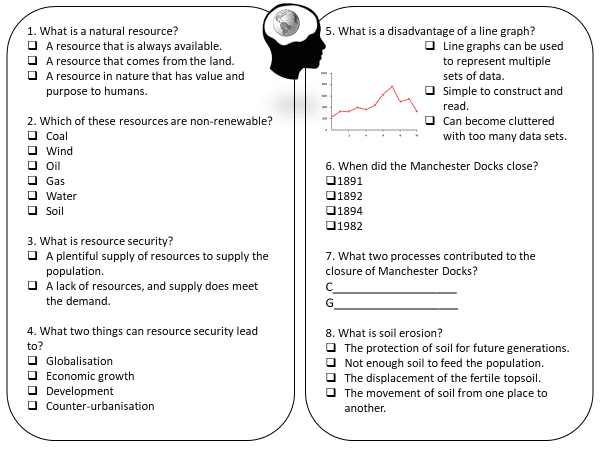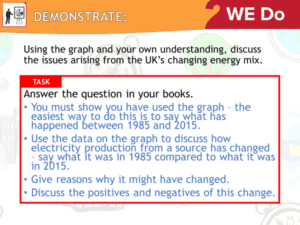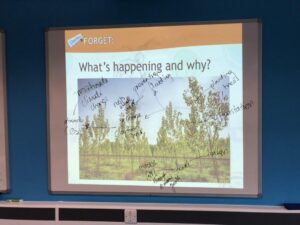Designing a curriculum in secondary subjects


This case study is written by James Tomlinson, Curriculum Leader of Geography at MEA Central.
As you read this case study, reflect on how the curriculum has been shaped and developed. Take some time to think about how some of these approaches might translate to your own context.
Designing a Curriculum
To define curriculum, Lambert and Hopkin, (2014) describe it as the answer to the question of what to teach in schools and why. The ‘why’ is important. At the start of my career and in my first Head of Department role I was asked what my vision for geography was, I replied ‘to put geography on the map’, and the pun was intended. Nobody ever questioned this very fluid and disconnected take on the importance of my subject. I was left to just get on with it. The result was a curriculum that worked; we got through it and increased option uptake and outcomes at GCSE, but not to its full potential. There was no ‘intent’ or vision; I rarely made a point of geography’s ‘big ideas’; and there was limited opportunity to draw explicit links between new content and the threshold concepts of the subject. I essentially taught units of work as separate entities and it was like starting again each time. Curriculum became synonymous with the timetable (Smith 2000; Lambert and Hopkin 2014) and little attention was given to curriculum design and development. The OfstedThe Office for Standards in Education, Children’s Services (2019) Inspection Framework has given new life to everything curriculum in schools and many teachers now have a better handle on the concept.
Now, when thinking about curriculum and making decisions about it, I refer to the intent, as outlined in Figure 1. This is the benchmark for making decisions about content, structure and sequencing.
According to Bromley (2019), a curriculum intent should provide answers to the importance of education at your school, what excellence looks like and the desired outcomes. As a new teacher, you should refer to your subject lead’s intent, discuss with them your own vision and use these to guide your planning. An essential task to curriculum design is deciding on the principles that will deliver your intent. My school have nine that I will outline next:
- Knowledge is power. The more a person knows, the easier it becomes for them to learn new things – the Matthew Effect. In his lecture, Hirsch, (2015) says that a core knowledge-based curriculum provides equity and significantly raises attainment. Pupils need to know stuff so they can ‘meet other citizens as equals’ (Hirsch, 2015), and most of what pupils need to know can be found in the National Curriculum. You must carefully select the knowledge you teach and in what order – even if it sometimes does not interest you, teach it. Our pupils are entitled to know it and might need it to learn something else in the future. Before I plan a lesson, I use several textbooks and non-fiction books to decide on the knowledge I want to teach in that lesson, and I write it down in a Word document. Then, I break it down further.
- Curriculum development is continuous. We have never arrived; pedagogy and subject matter are constantly changing. We must make sure our curriculum changes with it. Bromley (2019) argues one of the existing problems with curriculum was the lack of reflection on design, content and implementation – schools taught the same thing for too long because it was done. Instead, after you have taught a lesson, consider what worked and what did not to inform future teaching.
- Subject knowledge is highly valued. Teachers must be experts in their subjects. The main driver of a lesson should not be a PowerPoint or a worksheet but the narrative that the teacher provides to go with it. Read around your subject and bring this into your teaching.
- Literacy and language underpin everything. Pupils should be taught to speak, read and write. It sounds obvious, but many curriculums based on worksheet completion do not provide this to its full potential. To read more about this see Klein and Van Dijk (2019). Our curriculum has an oracy activity and a writing activity in every lesson, we avoid worksheets. Instead we have pupils write paragraphs and make use of the I do, you do, we do strategy changing the question slightly each time. It has many benefits such as writing for learning, reducing cognitive load, providing models in steps before working towards pupil autonomy. Thornton, (2019) writes more about this in his blog.
- The curriculum is centred around big ideas or threshold concepts. A threshold conceptA key concept which, once understood, can transform the stud can be viewed as ‘akin to a portal, opening up a new and previously inaccessible way of thinking about something. It represents a transformed way of understanding, or interpreting, or viewing something without which the learner cannot progress’ (Meyer and Land, 2003). Some examples might include:
- the link between grammar and meaning, or the need to use supporting evidence for ideas in English,
- the link between the natural environment and human survival in geography,
- the ability to recognise that all sources offer distinct perspectives of the past in history,
- the ability to read and interpret drawings and paintings in art,
- heat transferThe processes of applying learning to new situations in physics, or
- limit in maths.
A threshold concept is transformative and integrative; it changes your view of a subject matter or the wider subject landscape by knitting together big ideas. For instance, once a pupil understands urbanisation, they might better understand why some countries are less developed than others when learning about development, or why some places have a greater risk to geohazards than others when learning about earthquakes, volcanoes and tsunamis. After careful consideration, I have concluded several big ideas in my subject (see Figure 2). These reoccur across our curriculum.


- The curriculum is coherently planned and sequenced. ‘A curriculum as it develops should revisit the basic ideas repeatedly, building upon them until the pupil has grasped the full formal apparatus that goes with them’ (Bruner 1977 p.13).
- Teach for retention and understanding. Learning and memory are inseparable and the curriculum should support schema acquisition and retention. For a better understanding of memory see Taylor and Dibner, (2019). Dunlosky et al. (2013) outlines how testing, distributed practice, interleavingAn approach to learning where, rather than focusing on one p, elaboration and self-explanation are effective learning strategies. Teachers must look for ways of building this into their practice to avoid designing learning activity that promote activity over achievement. One of the ways we review prior learning is through our use of a ‘forget moment’ – we direct pupils to forget what we have just taught them for 3 minutes whilst we review what we have done in the past. After, we ask them to remember what we taught them in the present lesson before providing them with opportunities to practice (see the images below). This is usually done between teaching pupils what they need to know that lesson and the pupils using the knowledge in their practice.
- Assess with purpose. Rosenshine (2012) states that lessons should begin with a review of previous learning, which is supported by Dunlosky et al. (2013)’s findings on the impact of testing. Figure 3 illustrates an example of this. We begin lessons with a review of learning from 3, 6 and 9 lessons ago and aim for the 80% success rate that Rosenshine (2012) describes. In addition, we carry out two ‘big tests’ a year that assess cumulative knowledge.


- Teach to the top, no limits, no labels. We do not set groups; we do not create different lessons and worksheets for different pupils. We teach the same lesson to all groups; we have the same high expectations of all pupils regardless of their starting point. This ensures curriculum equity. We use our pedagogy and knowledge to provide the appropriate in-lesson scaffoldingProgressively introducing students to new concepts to suppor so that all pupils have a fantastic future and can meet others as equals in the future. Some examples of scaffolding include the I do, we do, you do strategy as well as Paivio dual codingIn qualitative research, coding involves breaking down data theory (1971).
To conclude, a strong curriculum should be knowledge based and grounded by big ideas and threshold concepts that reoccur throughout the curriculum allowing pupils to really immerse themselves into the subject. It should never become static and the emphasis should be on achievement and not activity. Before designing a curriculum, the intent and outcomes should be clear, and a set of principles established to help implement the intent. This will act as the benchmark for making decisions around the design, content and implementation. My deepened understanding is down to my school; MEA Central and my MA in Leading Learning. It is crucial to engage in the research around curriculum design if we are to do it and do it well. Before getting started on curriculum design, give these activities a try:
- Write down what you think the intent of your subject might be. Do this from your own experiences in the first instance. You might alter this later after engaging with the reading. Some go-to reads that include subject intents or purposes might be Standish and Sehgal Cuthbert, (2017) or Myatt, (2018a). It is equally important to go to your subject association’s website – they might have a teacher’s handbook.
- Consider a typical curriculum for your subject that a Year 6 or a Year 7 might encounter. What topics will they explore? In what order will you teach them? What are the big ideas you want them to know? Why do they need to know it? It might help to have the National Curriculum for your subject in front of you. After, read Myatt, (2018b)’s article on building curriculum coherence and consider how you would link two topics together through concepts.
- Finally, reflect on a lesson you have already planned and taught. Do you think a typical pupil will be able to recall the big ideas and knowledge you wanted them to remember from that lesson? Why do you think that? Did you design your explanation and their activities using your knowledge of how we learn? Read Dunlosky et al (2013)’s article on effective learning strategies as a tool to help you reflect. If you had to plan and teach the lesson again, would you do anything differently? Consider how the curriculum principles outlined above might play their part in this.
References
Bromley M (2019) School and College Curriculum Design Book One: Intent. England: Spark Education Books UK.
Bruner J (1977) The Process of Education (Second Edition). Cambridge: MA. Harvard University Press.
Dunlosky J et al. (2013). Improving Students’ Learning With Effective Learning Techniques. Psychological Science in the Public Interest. 14(1). pp.4-58.
Hirsch E D (2015) Equity, Attainment and Core Curriculum in Secondary Education. Cambridge Assessment. Presented at: Queens Theatre. Emmanuel College. 21 September 2015.
Klein P D and Van Dijk A (2019) Writing as a Learning Activity. In Dunlosky, J and Rawson K A (2019) (eds) The Cambridge Handbook of Cognition and Education. New York: Cambridge University Press. pp. 266 – 291.
Lambert D and Hopkin J (2014) A possibilist analysis of the geography national curriculum in England. International Research in Geographical and Environmental Education. 23(1). pp. 64-78.
Meyer E and Land R (2003) Threshold Concepts and Troublesome Knowledge: Linkages to Ways of Thinking and Practising within the Disciplines. Available from: http://www.leeds.ac.uk/educol/documents/142206.pdf (accessed 2 January 2020)
Myatt M (2018a) The Curriculum: Gallimaufry to coherence. Melton: John Catt Educational.
Myatt M (2018b) Building Curriculum Coherence. Impact 4. pp. 35-36.
Ofsted (2019) Education Inspection Framework Overview of the Research. Available from: https://assets.publishing.service.gov.uk/government/uploads/system/uploads/attachment_data/file/813228/Research_for_EIF_framework_100619__16_.pdf (accessed 2 January 2020)
Paivio A (1971) Imagery and Verbal Processes. New York: Holt. Rinehart and Winston.
Rosenshine B (2012) Principles of Instruction: Research based principles that all teachers should know. American Educator. 36(1). pp.12-19.
Smith M (2000) What is curriculum? Exploring theory and practice. Available from: http://infed.org/mobi/curriculum-theory-and-practice/ (accessed 2 January 2020)
Standish A and Sehgal Cuthbert A (2017) What Should Schools Teach? Disciplines, subjects and the pursuit of truth. London: UCL Institute of Education Press.
Taylor T and Dibner N (2019) Connecting the Dots: the collective power of relationships, memory and mindset in the classroom. Melton: John Catt Educational.
Thornton G (2019) I, We, You. Mr Thornton Teach. Available from: https://mrthorntonteach.com/2019/10/05/i-we-you/ (accessed 3 May 2020).














